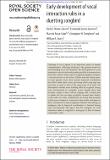Files in this item
Early development of vocal interaction rules in a duetting songbird
Item metadata
| dc.contributor.author | Rivera-Cáceres, Karla D. | |
| dc.contributor.author | Quirós-Guerrero, Esmeralda | |
| dc.contributor.author | Araya-Salas, Marcelo | |
| dc.contributor.author | Templeton, Christopher N. | |
| dc.contributor.author | Searcy, William A. | |
| dc.date.accessioned | 2018-03-22T16:30:06Z | |
| dc.date.available | 2018-03-22T16:30:06Z | |
| dc.date.issued | 2018-02-01 | |
| dc.identifier | 252596742 | |
| dc.identifier | 60a9776b-031a-4671-aa7a-a6ee77615c7d | |
| dc.identifier | 85043523699 | |
| dc.identifier | 000426465700072 | |
| dc.identifier.citation | Rivera-Cáceres , K D , Quirós-Guerrero , E , Araya-Salas , M , Templeton , C N & Searcy , W A 2018 , ' Early development of vocal interaction rules in a duetting songbird ' , Royal Society Open Science , vol. 5 , no. 2 , 171791 . https://doi.org/10.1098/rsos.171791 | en |
| dc.identifier.issn | 2054-5703 | |
| dc.identifier.uri | https://hdl.handle.net/10023/12999 | |
| dc.description | This work was supported by the Maytag Endowment from the University of Miami, a Research Grant from the Animal Behavior Society, a Research Grant from the Organization for Tropical Studies and a Doctoral Dissertation Improvement Grant by the National Science Foundation awarded to K.D.R.-C., and funds from Pacific University and the M.J. Murdock Charitable Trust to C.N.T. | en |
| dc.description.abstract | Exchange of vocal signals is an important aspect of animal communication. Although birdsong is the premier model for understanding vocal development, the development of vocal interaction rules in birds and possible parallels to humans have been little studied. Many tropical songbirds engage in complex vocal interactions in the form of duets between mated pairs. In some species, duets show precise temporal coordination and follow rules (duet codes) governing which song type one bird uses to reply to each of the song types of its mate. We determined whether these duetting rules are acquired during early development in canebrake wrens. Results show that juveniles acquire a duet code by singing with a mated pair of adults and that juveniles gradually increase their fidelity to the code over time. Additionally, we found that juveniles exhibit poorer temporal coordination than adults and improve their coordination as time progresses. Human turn-taking, an analogous rule to temporal coordination, is learned during early development. We report that the ontogeny of vocal interaction rules in songbirds is analogous to that of human conversation rules. | |
| dc.format.extent | 11 | |
| dc.format.extent | 692612 | |
| dc.language.iso | eng | |
| dc.relation.ispartof | Royal Society Open Science | en |
| dc.subject | Birdsong | en |
| dc.subject | Duet codes | en |
| dc.subject | Duet development | en |
| dc.subject | Duetting | en |
| dc.subject | Temporal coordination | en |
| dc.subject | Vocal interaction | en |
| dc.subject | QH301 Biology | en |
| dc.subject | DAS | en |
| dc.subject.lcc | QH301 | en |
| dc.title | Early development of vocal interaction rules in a duetting songbird | en |
| dc.type | Journal article | en |
| dc.contributor.sponsor | NERC | en |
| dc.contributor.institution | University of St Andrews. School of Biology | en |
| dc.identifier.doi | 10.1098/rsos.171791 | |
| dc.description.status | Peer reviewed | en |
| dc.identifier.grantnumber | NE/J018694/1 | en |
This item appears in the following Collection(s)
Items in the St Andrews Research Repository are protected by copyright, with all rights reserved, unless otherwise indicated.

